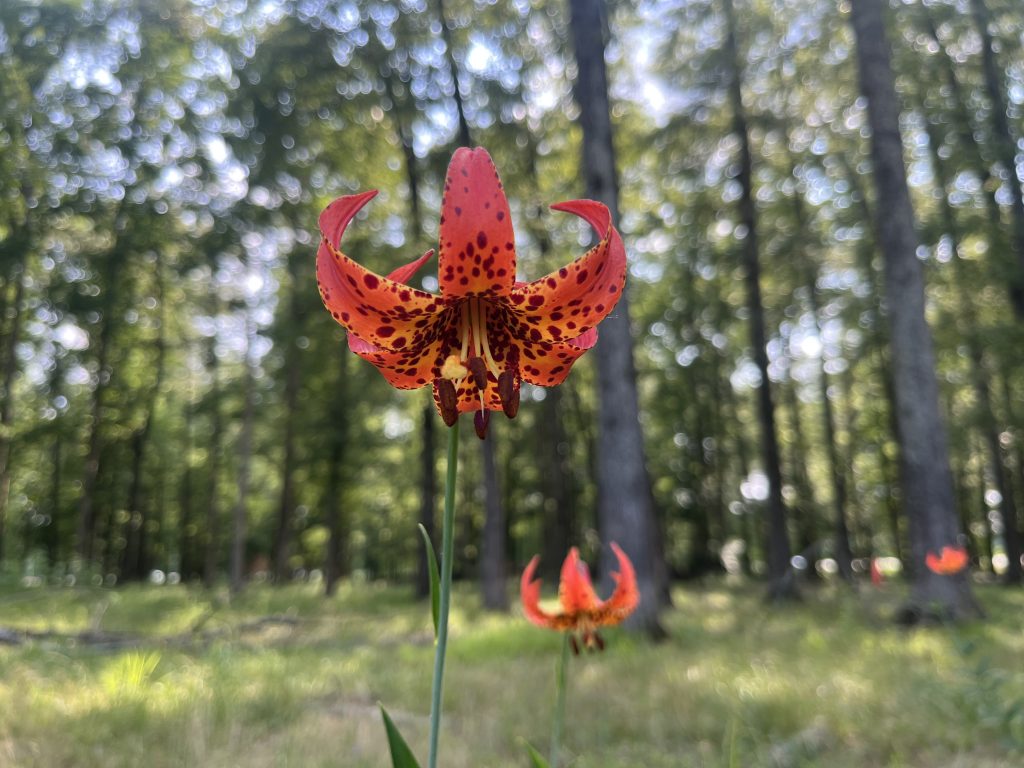Biodiversity at Elgie’s Walk Greenway
Published on August 1, 2025
By Lauren Linder
Secretary for the Wild Ones, North Alabama Chapter
Elgie’s Walk Greenway opened in 2020 along Haysland Road in the Hays Farm development in south Huntsville, a two-mile paved trail from Grissom High School to Bell Mountain Park. The greenway was named after the grandfather of John Hays, one of the Hays Farm developers. The Hays Family gifted Elgie’s Walk to the City of Huntsville as part of their commitment to green space. I was excited to learn about Elgie’s Walk. I especially appreciate the variety of plant species that can be spotted along the trail. I’ve been an amateur wildflower identifier for years, and a stroll along Elgie’s Walk has given me my first sightings of many new-to-me species.
I first learned about the somewhat uncommon woodland spider-lily (Hymenocallis occidentalis) from botanist Lynne Weninegar, but the ones we observed at Matthews Nature Preserve near Harvest weren’t ready to bloom yet. Imagine my surprise when I recognized the leaves in a few places at Elgie’s Walk! Not only that, but I was able to catch them when the flowers bloomed. I have spotted several stands of helmet skullcap (Scutellaria integrifolia), which is an adorable little blue-purple flower, and an American snowbell sapling (Styrax americanus), which was so cute I planted one in my own yard.

And there’s more than plants at Elgie’s Walk Greenway. Due to the ponds and vernal pools, a variety of animals use the area as well. In early years, I often spotted a fox squirrel. Still looking but I have not managed to see an alligator there yet. Just recently, I found a clutch of turtle eggs that had probably been dug up by a raccoon. And once when driving past on Haysland Road, I saw a muskrat at one of the ponds. I’ve even seen an otter in the area.
However, most exciting is finding a few species that are endangered. At the end of May, I spotted some really cool looking flowers. They were Michigan lilies (Lilium michiganense). In Alabama, it is considered an S1 species – this means that it is “critically imperiled” in this state. In fact, Helen Czech, a field biologist at Alabama A&M University, said the stands of Michigan lily we found at Elgie’s Walk were the most impressive she’s ever seen. Helen also found lakecress (Rorippa aquatica), which is also S1 in Alabama. In 2022, I once found a couple dwarf trillium (Trillium pusillum). It is considered S2 (“imperiled”) in Alabama. Finally, landscape designer Denise Woodring found a barbed rattlesnake root (Nabalus barbatus). This species is S1S2 in Alabama, meaning it is between “imperiled” and “critically imperiled,” but it is also considered G3, meaning it is “vulnerable – at moderate risk of extinction or elimination” (NatureServe) on a global scale.
Protecting biodiversity
Human behavior can harm biodiversity. Habitat fragmentation supports fewer species and creates more edge habitat. Residential areas are usually landscaped with large monocultures of turf grass, leading to deserts for native pollinators and the species that depend on them. Traditional landscape maintenance leads to overreliance on herbicides, pesticides and mowing.
But there are also ways we can support biodiversity. While the initial mowing has been beneficial, chronic over-mowing will destroy this area of amazing biodiversity. It is crucial that we strike a balance on preserving and maintaining this space. One thing to do is to designate areas for different mowing frequency. A natural resource management plan would specify what methods should be used in what area and when certain actions should be taken (or not).
Creating a project through iNaturalist would allow anyone in the area to contribute as “citizen scientists” while also learning and getting feedback from the many professionals that use the app. Finally, informational signs can be installed in certain areas to teach visitors facts about what they are seeing.
